 |
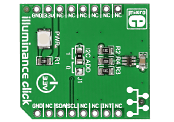
|
|
Illuminance click carries a TSL2561 light-to-digital converter with a sensor that's designed to mimic the way humans perceive light. This makes it ideal for applications where ambient lighting conditions have to be measured (backlight power-saving on LCD displays for example). The sensor has two photodiodes. One sensitive to full-spectrum light, the other to infrared. The visible-spectrum is then deduced by using a formula. Illuminance click communicates with the target board through mikroBUS I2C lines, and uses a 3.3V power supply. |
|
|
|
 |
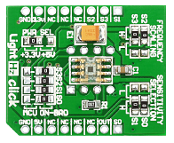
|
|
LightHz Click is an accessory board in the mikroBus form factor. The board features the TSL230BR programmable light-to-frequency converter. The output can be either a pulse train or a square wave (50% duty cycle), with frequency directly proportional to light intensity. Device sensitivity is selectable in three ranges, providing two decades of adjustment. The full-scale output frequency can be scaled by one of four preset values. The board features a voltage selection SMD jumper which determines whether it will operate on 5V or 3.3V. |
|
|
|
 |
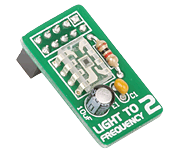
|
|
The Light to Frequency 2 Board enables you to connect your development board to a light-to-frequency converter. The board features a programmable light-to-frequency converter TSL230BR and is connected to a prototype device via an IDC10 connector. |
|
|
|
 |
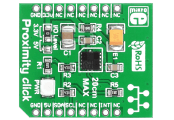
|
|
Proximity click features a VCNL4010 proximity and ambient light sensor. It combines an infrared emitter and PIN photodiode for proximity measurement with a range of up to 20cm. The VCNL4010 has a 16bit resolution which ensures excellent cross talk immunity. It can also be used as an ambient light sensor. Proximity click communicates with the target board microcontroller via mikroBUS I2C (SDA, SCL) and INT lines. The board is designed to use 3.3V power supply and 3.3V or 5V I/O voltage levels. |
|
|
|
 |
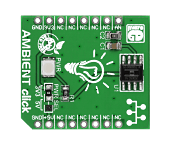
|
|
Ambient click carries the Melexis MLX75305 IC. It's a CMOS integrated optical sensor that consists of a photodiode, a transimpendance amplifier, and an output transistor. The chip converts ambient light intensity into a voltage, using the mikroBUS AN pin for communicating with the target board MCU. The board is designed to use either a 3.3V or a 5V power supply. |
|
|
|
 |

